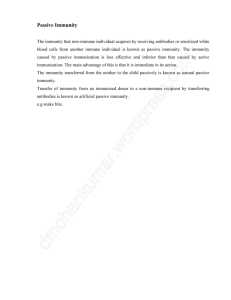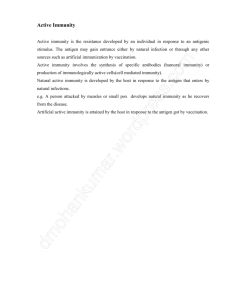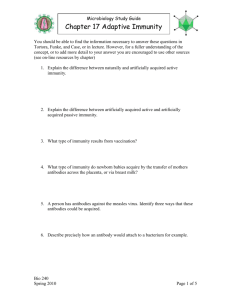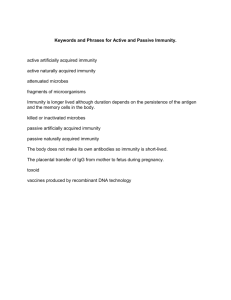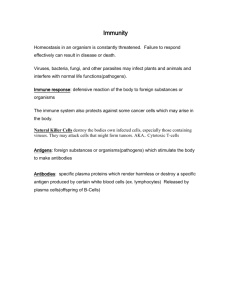Immunity and Vaccinations
advertisement
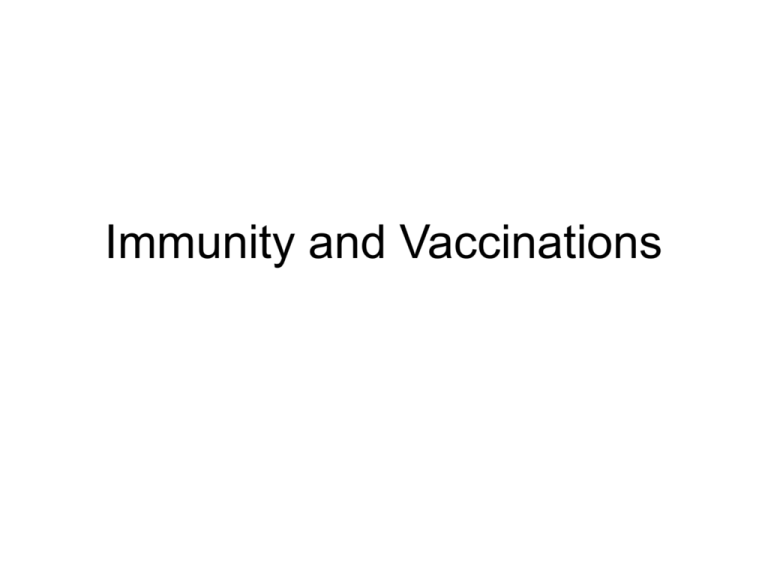
Immunity and Vaccinations Natural Active immunity • If you survive an infection with a pathogen e.g. Vibrio cholerae you usually acquire permanent immunity against that organism. • During primary response one B cell is activated by a specific antigen that has a complementary shape to that of the immunoglobulin on the cell surface of the B cell. • The B cell divides many times to form a clone of cells which can produce identical antibodies against the antigen. Some of the B cells resulting from mitosis become memory cells. Second Exposure • If person is exposed to same antigen again, the secondary response takes place. • The memory cells formed in the primary response divide to form a large population of B cells. • Each one of these can produce clones that can make antibodies to destroy the antigen or disease agent • The secondary response is faster and greater than the primary response because it starts with a large number of memory cells rather than one B cell Artificial active immunity • This can reinforce natural immunity e.g. vaccination. • Vaccination was first used by Edward Jenner – http://www.bbc.co.uk/history/historic_fi gures/jenner_edward.shtml How vaccinations work • Involve using weakened pathogens – called attenuation. • It can be natural (as in cowpox) or it may be carried out artificially by - • Culturing the pathogen repeatedly in high or low temps, or without oxygen, until suitable mutants occur (e.g. the Sabin poliomyelitis vaccine) • Using viruses or bacteria that have been killed so that they still trigger the immune response but cannot induce the disease e.g. the Salk poliomyelitis vaccine • Use inactivated toxins called toxoids that are harmless but trigger the same type of immune response e.g. diphtheria and tetanus vaccines. Herd Immunity • Ideally vaccinations for highly contagious diseases should be given to a large number of people at the same time. This gives a general immunity to the population called herd immunity. • Vaccinations are not equally effective on all people – in fact some people will not respond at all. They may have inherited a defective immune system or their defences may already have been weakened by disease or malnutrition. • How does herd immunity offer these people some protection? Antigenic variation • Some diseases are difficult to vaccinate against e.g. the influenza virus because they mutate regularly and change their surface antigens. • Our immune systems can recognise small changes (known as antigenic drift) but not large changes (antigenic shift) such as the one that caused Hong Kong ‘flu in 1997 http://www.sciencefriday.com/pages/19 97/Dec/hour1_121997.html • The way the influenza virus evades attack is called Antigenic Variation • Antigenic concealment – this is where pathogens avoid the immune system in another way. E.g. Vibrio cholerae lives on the wall of the intestine bathed in intestinal juices. • How does this mean it avoids the immune system? • The vibrio cholerae bacterium also undergoes considerable antigenic variation • This is why it spreads so rapidly and is very virulent Passive immunity • Active immunity, whether natural or artificial is not immediate. During the delay between infection and full immune response, some disease causing agents, such as the toxins from Clostridium tetani can kill. • A person infected with a lifethreatening disease such as tetanus may be given readymade antibodies against the toxin. This is called passive immunity. Natural Passive Immunity • This occurs when a fetus is still in the uterus. Maternal antibodies cross the placenta into fetal blood. • They may protect the baby for example against measles, during the first few months after birth. Infants also acquire some passive immunity from the antibodies in colostrum (the first milk produced by a lactating mother). • Passive immunity is only temporary – Why? Now answer the following 1. Which type of immunity involves the body making its own antibodies in response to an antigen? 2. Why are influenza vaccines sometime not effective? 3. Why is the secondary response to an infection quicker than the primary response? 4. Explain why passive immunity is only temporary. • The antibodies are eventually broken down by the spleen and liver • There is no immunological memory because the baby did not make the antibodies for itself.

